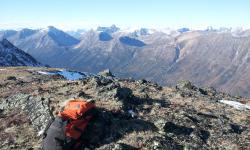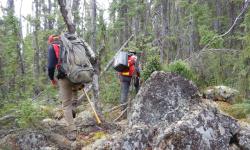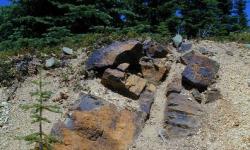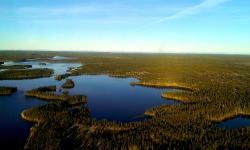Eagle Plains Executes Option Agreement with Canter on Schott’s Lake Copper Project, Saskatchewan
Saskatchewan | July 22, 2021Cranbrook, B.C., July 22, 2021: Eagle Plains Resources Ltd. (TSX-V: “EPL”) and Canter Capital Corp. (a private BC corporation) have executed a formal agreement whereby Canter holds the exclusive right to earn a 60% interest in EPL’s 100%-owned Schott’s Lake copper-zinc project by completing $5,000,000 in exploration expenditures, making $500,000 in cash payments and issuing 1,000,000 common shares to Eagle Plains over a four year period. A 2% NSR is reserved for Eagle Plains, which may be reduced to 1% upon payment by Canter of $1M. The claims cover an area of 2,160ha located in northeastern Saskatchewan, 40 km northwest of Flin Flon, Manitoba. Access to the property is gained via winter road and/or float plane.
Eagle Plains has recently completed a ground-based electromagnetic survey over 6.5 line-kms, covering known mineralization and surveying areas interpreted to have high potential. 3-D modelling of existing drill hole data is now underway. The objective of the 2021program is to identify possible down-plunge extensions of the existing deposit and search for similar mineralization elsewhere in the property.
See Schott’s Lake property details here
Schott’s Lake Geology and History
The Schott’s Lake property hosts metamorphic and intrusive rocks which are dominantly volcanic in origin and associated with an island arc environment. The rocks are folded into an easterly-dipping synform. Mineralization was first discovered in 1953 by Kay Lake Mines. A total of 79 drill holes have been completed for a total of 9516m (31,200’) and a historical resource of 1,983,850 tonnes grading 0.61% copper and 1.35% zinc (Aur Resources, 2003-SDMI 0320). Notably, the historical resource did not include precious metal enrichment and/or cobalt. Eagle Plains’ management considers these estimates to be historical in nature and cautions that a Qualified Person has not done sufficient work to classify the historical estimates as current mineral resources or mineral reserves in accordance with National Instrument 43-101. These estimates do not comply with current definitions prescribed by National Instrument 43-101 or the Canadian Institute of Mining and are disclosed only as indications of the presence of mineralization and are considered to be a guide for additional work. The historical models and data sets used to prepare these historical estimates are not available to Eagle Plains, nor are any more recent resource estimates or drill information on the Property.
Mineralization at Schott’s Lake consists of semi-massive to massive pyrrhotite and pyrite with associated chalcopyrite (copper) and sphalerite (zinc) mineralization. The Schott’s Lake deposit is interpreted to be a typical exhalative massive sulphide zone. The mineralized zone has an average thickness of 20.4m, is overturned and lies on the eastern limb of a major north-easterly plunging fold. The deepest mineralized intercept is at a vertical depth of 266 meters with mineralization open to depth.
The following table outlines significant historical drill intercepts:
Table 1- Significant Drill Intercepts-Schotts Lake Project*
| Hole ID | Width (m) | From (m) | To (m) | Cu (%) | Zn (%) |
|---|---|---|---|---|---|
| 1 | 16.7 | unknown | unknown | 1.1 | 1.83 |
| 4 | 0.76 | unknown | unknown | 4.3 | 3.3 |
| 13 | 5.8 | 30.4 | 36.2 | 2.5 | 0.17 |
| 35 | 1.7 | 256.8 | 258.5 | 2.07 | 0.01 |
| 65 | 15.8 | 82.3 | 98.1 | 0.38 | 1.84 |
| 66 | 7.6 | 71.6 | 79.2 | 0.96 | 5.48 |
| 67 | 3.0 | 49.1 | 52.1 | 1.71 | 3.48 |
| 68 | 17.9 | 133.8 | 151.7 | 0.85 | 1.53 |
| 69 | 18.3 | 128.2 | 146.5 | 0.53 | 1.09 |
| 70 | 22.7 | 149.7 | 172.4 | 0.54 | 1.96 |
| 75 | 27.4 | 183.5 | 210.9 | 0.35 | 2.25 |
* intercepts in the above table refer to actual drilled thickness in meters and may not represent the true thickness of the intercept
Charles C. Downie, P.Geo., a “qualified person” for the purposes of National Instrument 43-101 - Standards of Disclosure for Mineral Projects, has prepared, reviewed, and approved the scientific and technical disclosure in the news release.
About Eagle Plains Resources
Based in Cranbrook, B.C., Eagle Plains continues to conduct research, acquire and explore mineral projects throughout western Canada. The Company is committed to steadily enhancing shareholder value by advancing our diverse portfolio of projects toward discovery through collaborative partnerships and development of a highly experienced technical team. Eagle Plains also holds significant royalty interests in western Canadian projects covering a broad spectrum of commodities. Management’s focus is to advance its most promising exploration projects. In addition, Eagle Plains continues to seek out and secure high-quality, unencumbered projects through research, staking and strategic acquisitions. Throughout the exploration process, our mission is to help maintain prosperous communities by exploring for and discovering resource opportunities while building lasting relationships through honest and respectful business practices.
Expenditures from 2011-2020 on Eagle Plains-related projects exceed $22M, the majority of which was funded by third-party partners. This exploration work resulted in approximately 37,000 m of diamond-drilling and extensive ground-based exploration work facilitating the advancement of numerous projects at various stages of development.
On behalf of the Board of Directors
“Tim J. Termuende”
President and CEO
For further information on EPL, please contact Mike Labach at 1 866 HUNT ORE (486 8673)
Email: mgl@eagleplains.com or visit our website at https://www.eagleplains.com
Cautionary Note Regarding Forward-Looking Statements
Neither the TSX Venture Exchange nor its Regulation Services Provider (as that term is defined in the policies of the TSX Venture Exchange) accepts responsibility for the adequacy or accuracy of this release. This news release may contain forward-looking statements including but not limited to comments regarding the timing and content of upcoming work programs, geological interpretations, receipt of property titles, potential mineral recovery processes, etc. Forward-looking statements address future events and conditions and therefore, involve inherent risks and uncertainties. Actual results may differ materially from those currently anticipated in such statements.
Latest News Releases

Eagle Plains and Sun Summit Minerals Execute Option Agreement for the Theory Copper-Gold Project, British Columbia

Eagle Plains and Earthwise Minerals Execute Option Agreement for the Iron Range Gold Project, British Columbia

Eagle Plains and Partner Refined Energy Receive Permit for Drilling at Dufferin West Uranium Property, Saskatchewan

Eagle Plains Announces Letter of Intent with Earthwise Minerals for Option of the Iron Range Project, British Columbia

Eagle Plains Partner Xcite Resources Reports Results From Fieldwork at the Uranium City Area Projects, Saskatchewan

